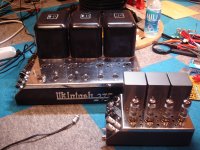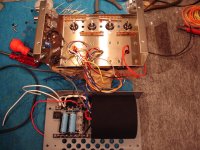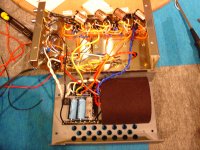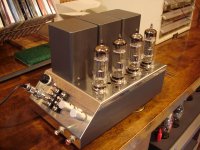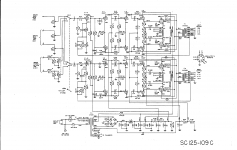Rosinante ,
You can Goggle One Electron and send an email to them about the Output Tranny's. There are some other great sources you will just have to do a little research.
The Mac gear is not by any means high tech. When the early tube units were build nice little grey haired woman hand wound the cores on open spindles. The wire is not neat or organized. If you were to find some old shorted out Mac tranny's you could unwrap, document, unstack, varnish, restack and rewind at home with no problem at all. Except the tar. That stuff is nasty.
I would buy after market gear from and audio outfit. The quality would be better plus reputation.
You will not find to many Mac officianados here at DIY audio. I like there stuff a lot. I have owned many a Mac unit and was extremely happy. Of course when I built my first Leach amp all of the Mac stuff left on ebay. Nothing beats homemade.
Have fun and keep us in the loop. TAd
You can Goggle One Electron and send an email to them about the Output Tranny's. There are some other great sources you will just have to do a little research.
The Mac gear is not by any means high tech. When the early tube units were build nice little grey haired woman hand wound the cores on open spindles. The wire is not neat or organized. If you were to find some old shorted out Mac tranny's you could unwrap, document, unstack, varnish, restack and rewind at home with no problem at all. Except the tar. That stuff is nasty.
I would buy after market gear from and audio outfit. The quality would be better plus reputation.
You will not find to many Mac officianados here at DIY audio. I like there stuff a lot. I have owned many a Mac unit and was extremely happy. Of course when I built my first Leach amp all of the Mac stuff left on ebay. Nothing beats homemade.
Have fun and keep us in the loop. TAd
Search DIYaudio for Norman Crowhurst's "Twin-Coupled Amplifier". Probably a few threads here. Same thing as Mac.
This is not true... A different topology... No offense but I sespect that many who have posted here may have an old Mac but have not built one from scratch. The only thing needed to get that mac sound is the "unity coupled" output transformer... That is the only special item involved and is the "make or break" item. I have several Mac "clones" that I have built because I have bought the output iron off of Ebay for decent prices. I have output iron from 2 MI-60's, A pair from MC-60's, and a pair from the MI-350 / MC3500 that I have not built an amp around them yet because, yes, those will be pricy to build around. I bought the MI-60 outputs for under $300/pair because the guy who sold them didn't know what they were.
The MC-60 "clone" amps that I have, excluding the output iron, cost under $1000 in parts to build the pair. The amps around the MI-60 outputs cost less than $500 for the pair because I had a bunch of junk parts that suited the build well. These amps look nothing like the nice old chrome plated Mac's but sound identical to them. I have owned original MAC mc-30's, Mc-40's, and Mc-60's in the past, so I have been able to compare my builds to the originals. I sold the originals for crazy money and kept my ugly ones as I am into this for the sound and not for collecting.
As another poster wrote... Many other amp topologies sound better than the old MAC's, so I don't know why so many people worship the old Macs. They do look nice. Their specs are excellent and McIntosh severly under-rated them. They make great PA amps... They are durable (with tubes protected), and they can take a lot of abuse, but there are better amps for listening at home.
Daniel
Last edited:
This Leach amp.....is solid state? Fairly simple, it appears.
Could/would a solid state power amp combined with a tube preamp sound warm and rich and full and airy?
For those of you who have had and used good-condition (reconditioned, in-spec) Mac tube amps......are you saying there are amp designs today that sound better? Really? (he says, with a look of incredulity)
As a musician, years ago, I developed a respect for both tube and solid state gear. To this day, serious musicians commonly will simply pack their instruments up and go home if their beloved tube amp will not fire. There is simply no alternative way to achieve their sound. Solid state amps were used simply for power. They tended to be awesomely bright and forceful, and were tougher and more reliable, but without a tube sound at the front end, they were almost painful to listen to. IMHO. YMMV.
Could/would a solid state power amp combined with a tube preamp sound warm and rich and full and airy?
For those of you who have had and used good-condition (reconditioned, in-spec) Mac tube amps......are you saying there are amp designs today that sound better? Really? (he says, with a look of incredulity)
As a musician, years ago, I developed a respect for both tube and solid state gear. To this day, serious musicians commonly will simply pack their instruments up and go home if their beloved tube amp will not fire. There is simply no alternative way to achieve their sound. Solid state amps were used simply for power. They tended to be awesomely bright and forceful, and were tougher and more reliable, but without a tube sound at the front end, they were almost painful to listen to. IMHO. YMMV.
I completely agree with Daniel.
Some time ago I had a MC-275 here, a "modern" one with pcb's inside.
Sounding good in the bass but otherwise pretty disappointing, not what you expect from a tube amp (no I don't mean the vintage warm, lean tube sound).
Comparison was with my Yamaha B2 VFet amplifier, speakers were Yamaha NS1000 (which are known to combine very well with tube amplifiers); the Yamaha combo just sounded better.
Output transformers of modern Mac's pretty often fail, I wrote about my experience in an earlier thread.
As a transformer guy I like the unity coupling technique a lot however, and I am sure that very good (sounding) amplifiers can be made using the technique.
Look at Pete Millet's site and find after some searching an article by Hugh Alvin Lockhart, who in 1956 describes a "McIntosh audio amplifier incorporating a trifilar output transformer". This is a really nice schematic I think, and I plan to build an amplifier along these lines using direct heated 1624's as outputs (have quite some of these).
Pieter
Some time ago I had a MC-275 here, a "modern" one with pcb's inside.
Sounding good in the bass but otherwise pretty disappointing, not what you expect from a tube amp (no I don't mean the vintage warm, lean tube sound).
Comparison was with my Yamaha B2 VFet amplifier, speakers were Yamaha NS1000 (which are known to combine very well with tube amplifiers); the Yamaha combo just sounded better.
Output transformers of modern Mac's pretty often fail, I wrote about my experience in an earlier thread.
As a transformer guy I like the unity coupling technique a lot however, and I am sure that very good (sounding) amplifiers can be made using the technique.
Look at Pete Millet's site and find after some searching an article by Hugh Alvin Lockhart, who in 1956 describes a "McIntosh audio amplifier incorporating a trifilar output transformer". This is a really nice schematic I think, and I plan to build an amplifier along these lines using direct heated 1624's as outputs (have quite some of these).
Pieter
For those of you who have had and used good-condition (reconditioned, in-spec) Mac tube amps......are you saying there are amp designs today that sound better? Really? (he says, with a look of incredulity)
Triode output tubes, no negative feedback, fully regulated power supplies, permalloy output transformers(like old UTC LS units)... Single ended or push-pull... Go wild!
"Norman Crowhurst's "Twin-Coupled Amplifier". ..... Same thing as Mac."
"This is not true... A different topology... "
Yes, true enough, they are not identical per se. But functionally, the Twin Coupled arrangement provides the same 50% CFB (cathode feedback), and the same Unity Coupling (via the crossed Plate- Cathode caps instead of the bifilar winding, Mac even adopted this technique later). If these are the only "factors" of importance, note that the EV Circlotron does this even better.
The "sound" of the Mac, I would say, is more related to the high levels of FDBK. The unity coupling merely allowed Mac to lower the output bias currents closer to class B for efficiency. Then they clobbered the resulting bad crossover distortion with a pile of FDBK. I suspect that Norman's Twin Coupled Amp on the other hand was just biased higher to avoid the crossover dist. and then used less FDBK. It might well sound better to many. In any case, I would just use the Twin C OT technique to avoid the expensive bifilar OT, and then re-design the whole circuitry anyway, to use Sweep Tubes (some are much better than the usual audio outputs, verified by curve tracer). Or just go Circlotron.
But I have to agree overall, why bother trying to get Mac sound. You can do better. And even the 50% CFB and special OT arrangements of either Mac or Twin C or Circlotron are really unnecessary, just use some form of Shade feedbacks with a normal OT (popular on the forum lately too, try Pete Millett's board, it even uses Sweep Tubes, and George -Tubelab- has vetted out a bunch of higher power Sweeps that work well on it).
"This is not true... A different topology... "
Yes, true enough, they are not identical per se. But functionally, the Twin Coupled arrangement provides the same 50% CFB (cathode feedback), and the same Unity Coupling (via the crossed Plate- Cathode caps instead of the bifilar winding, Mac even adopted this technique later). If these are the only "factors" of importance, note that the EV Circlotron does this even better.
The "sound" of the Mac, I would say, is more related to the high levels of FDBK. The unity coupling merely allowed Mac to lower the output bias currents closer to class B for efficiency. Then they clobbered the resulting bad crossover distortion with a pile of FDBK. I suspect that Norman's Twin Coupled Amp on the other hand was just biased higher to avoid the crossover dist. and then used less FDBK. It might well sound better to many. In any case, I would just use the Twin C OT technique to avoid the expensive bifilar OT, and then re-design the whole circuitry anyway, to use Sweep Tubes (some are much better than the usual audio outputs, verified by curve tracer). Or just go Circlotron.
But I have to agree overall, why bother trying to get Mac sound. You can do better. And even the 50% CFB and special OT arrangements of either Mac or Twin C or Circlotron are really unnecessary, just use some form of Shade feedbacks with a normal OT (popular on the forum lately too, try Pete Millett's board, it even uses Sweep Tubes, and George -Tubelab- has vetted out a bunch of higher power Sweeps that work well on it).
Last edited:
Both methods (Mc and Crow) use local feedback from the primary of the OPTs.
Fine except the load is connected to the secondary...
I like the ARC ST-70-C3, what stands output cathodes on 0 and 16 taps of the
secondaries, and grounds out the 4 Ohm tap instead...
audioresearchst-70-c3amplifier - mpbarneyamps
Fine except the load is connected to the secondary...
I like the ARC ST-70-C3, what stands output cathodes on 0 and 16 taps of the
secondaries, and grounds out the 4 Ohm tap instead...
audioresearchst-70-c3amplifier - mpbarneyamps
The point I am driving at here: Is that no matter how good the primary side
distortion may be controlled by cathode feedback - Distortion across OPT(s)
has to be handled by a long shifty GNF loop, if you don't feed secondaries
back to cathodes as ARC has done.
distortion may be controlled by cathode feedback - Distortion across OPT(s)
has to be handled by a long shifty GNF loop, if you don't feed secondaries
back to cathodes as ARC has done.
Last edited:
Well, you can apply plenty of local feedback(s) without getting OT phase shift problems, so that is good for fixing the tube distortions, crossover dist., magnetizing current, and primary distributed capacitance. Then only a modest amount of global feedback is needed for the OT resistance, leakage inductance, and secondary distributed capacitance. Ie, frequency droop and damping factor. Some might not even want to fix those two problems.
The AR setup looks to me to be sub-optimal, too little local feedback. Better to run that CT 16 Ohm setup back to some driver inputs instead of CFB for the outputs. Better yet to just skip it. See below.
The issue I see with the Mac type setup is that the class B crossover distortion requires a lot of feedback somewhere to fix it. Easy enough to fix though, just increase the bias current into optimum class AB. But then you don't really need all that fancy bifilar stuff or mega-feedback. There are better ways to deal with the residual class AB crossover distortion nowadays anyway:
European Triode Festival and Crossover Notch Distortion and New OTL Design
(2nd diagram up from bottom)
Oddly, Broskie only presented a totem pole tube version, its actually almost trivial to implement that scheme for a conventional center tapped primary P-P with local Schade-like feedbacks -- to the driver inputs though. (Hint: driver needs to be differential, and the two plate current sense resistors get stuck in where it looks like they don't do anything. OK, above the Schade feedbacks, wouldn't want you to lose sleep tonight trying to solve it.) 20 dB of improvement beats class A operation anyday. Interestingly enough, a lousy high primary Resistance OT may already do the job without the sense resistors. This may be one of the last great missing pieces of tube tech. I'm wondering if Broskie has plans to reveal it in his current output stage design blogs.
The AR setup looks to me to be sub-optimal, too little local feedback. Better to run that CT 16 Ohm setup back to some driver inputs instead of CFB for the outputs. Better yet to just skip it. See below.
The issue I see with the Mac type setup is that the class B crossover distortion requires a lot of feedback somewhere to fix it. Easy enough to fix though, just increase the bias current into optimum class AB. But then you don't really need all that fancy bifilar stuff or mega-feedback. There are better ways to deal with the residual class AB crossover distortion nowadays anyway:
European Triode Festival and Crossover Notch Distortion and New OTL Design
(2nd diagram up from bottom)
Oddly, Broskie only presented a totem pole tube version, its actually almost trivial to implement that scheme for a conventional center tapped primary P-P with local Schade-like feedbacks -- to the driver inputs though. (Hint: driver needs to be differential, and the two plate current sense resistors get stuck in where it looks like they don't do anything. OK, above the Schade feedbacks, wouldn't want you to lose sleep tonight trying to solve it.) 20 dB of improvement beats class A operation anyday. Interestingly enough, a lousy high primary Resistance OT may already do the job without the sense resistors. This may be one of the last great missing pieces of tube tech. I'm wondering if Broskie has plans to reveal it in his current output stage design blogs.
Last edited:
The "sound" of the Mac, I would say, is more related to the high levels of FDBK.True statement.... Mac's do sound rather compressed which is a result of the loads of feedback used in their circuit. But they don't only use neg feedback; they use positive feedback in bootstraping the driver's (12BH7) plates to the plate windings of the output transformer in order to boost the gain of the whole amp.
The AR setup looks to me to be sub-optimal, too little local feedback. Better to run that CT 16 Ohm setup back to some driver inputs instead of CFB for the outputs. Better yet to just skip it.
Nothing wrong with GNF if you can guarantee that no signal will ever stray
from the envelope of common sense. Its when transients ask an amp to do
the impossible that GNF hits the fan. When an unfixable error occurs, will
integrate and store on caps throughout the whole GNF chain, and takes a
lot longer to recover.
Since the worst distorter is the OPT, makes most sense to fix it locally
in a way that does not integrate unfixable errors when they happen.
Remember, if you are driving a loudspeaker, its a moving target. Can't
assume the amp will never clip on the basis of input amplitude alone.
The unfixable is gonna happen, deal with it...
I agree with biasing square law beam tetrodes for smoothest class AB
crossing, rather than lowest class aB quiescent. If you choose a valve
that is excessively linear, without square law, or just want to cross it
ridiculously low: You can throw a stack of Scottky diodes under the
cathodes to create the required mating curvature. Expecting feedback
to fix a nasty crossing is not equal to having a smooth crossing.
Last edited:
The issue I see with the Mac type setup is that the class B crossover distortion requires a lot of feedback somewhere to fix it. Easy enough to fix though, just increase the bias current into optimum class AB. But then you don't really need all that fancy bifilar stuff or mega-feedback. There are better ways to deal with the residual class AB crossover distortion nowadays anyway:
Take another look at the Mac output circuit... The way the output tubes are configured with the output transformer, there really isn't crossover distortion in this circuit as both halves of the output transformer are always "on" and with the exact same current going through both halves... And you don't even have to match the output tubes! That's why they didn't go with class AB operation to reduce distortion... It wouldn't.
For instance.... The upper output tube in the MAC circuit is conducting, the lower tube is at cutoff. No worries... One half of the transformer's primary is cunducting current through the top tube's plate connection and the other half of the output transformer primary is conducting current through the same tube's cathode connection which means the signal is out of phase because it's the cathode; perfect for the other half of the transformer, the signal needs to be out of phase on that half.
I am probably not describing this well here... There is a book called "the audio encyclopedia" which does a much better job.
Daniel
The AR setup looks to me to be sub-optimal, too little local feedback. .
This is actually a good way to use feedback to tighten up the output section of an amp without introducing the dreaded GNF that makes amps sound bad. The problem with this setup though is that another stage of gain usually has to be introduced into the amp to keep output power optimal.
The definitive explanation of how these clever and innovative circuits work is Crowhurst's "Realistic Audio Engineering Philosophy." Originally appearing in Audio Engineering magazine, it was reprinted in AudioXpress's "Audio Anthology." There are pdfs of it floating around the 'Net.
R,
The main reason that Mcintosh amps have received a bad rap here on DIY audio has been associated with prodigious use of feedback. They use this in the tube and solid state units to garner very respectable distortion figures. Back in the early days mega digit distortion specs are what you bragged to your buddies about.
Now a days with large amounts of money in the bank, the house paid off and the kids gone you can sit back and brag about how good it sounds. Most of the time you will be bragging to the dog.
Real expensive toys are no fun if your friends are not green with jealousy..
My DIY Leach sounds way better than any high dollar audiophile amp I ever owned and it is ugly.
Do your homework, build it and enjoy. Like they said before me there are many simpler, cheaper better sounding tube amps than Mcintosh. Where I can not say.
Tad
The main reason that Mcintosh amps have received a bad rap here on DIY audio has been associated with prodigious use of feedback. They use this in the tube and solid state units to garner very respectable distortion figures. Back in the early days mega digit distortion specs are what you bragged to your buddies about.
Now a days with large amounts of money in the bank, the house paid off and the kids gone you can sit back and brag about how good it sounds. Most of the time you will be bragging to the dog.
Real expensive toys are no fun if your friends are not green with jealousy..
My DIY Leach sounds way better than any high dollar audiophile amp I ever owned and it is ugly.
Do your homework, build it and enjoy. Like they said before me there are many simpler, cheaper better sounding tube amps than Mcintosh. Where I can not say.
Tad
The main reason that Mcintosh amps have received a bad rap here on DIY audio has been associated with prodigious use of feedback.
Really? How much global feedback does (say) the 275 use?
Maybe someone can figure it out...here are the turn ratios: http://www.diyaudio.com/forums/tubes-valves/32017-mc275-opt-manual-rewinding-5.html#post377645 and attached is the schematic.
From testing my MC75s I can say that the amps pick up mobile phone interference quite well, which may indicate that the phone's AM HF signal's envelope is detected by the slightly non-linear amplifying-circuit, which in turn is linearized by nested and global NFB, no? Or is it just the tubes sticking out, and, besides the input-stage valve, not being shielded by anything other than glass and vacuum?
I haven't experienced this EMI behaviour with my other amps (PASSDIY mostly) and I usually don't care for a case...
From testing my MC75s I can say that the amps pick up mobile phone interference quite well, which may indicate that the phone's AM HF signal's envelope is detected by the slightly non-linear amplifying-circuit, which in turn is linearized by nested and global NFB, no? Or is it just the tubes sticking out, and, besides the input-stage valve, not being shielded by anything other than glass and vacuum?
I haven't experienced this EMI behaviour with my other amps (PASSDIY mostly) and I usually don't care for a case...
Attachments
- Status
- This old topic is closed. If you want to reopen this topic, contact a moderator using the "Report Post" button.
- Home
- Amplifiers
- Tubes / Valves
- McIntosh Goodness From Scratch
